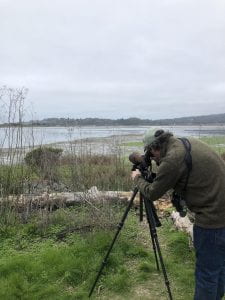Ebird List Link: https://ebird.org/checklist/S64772250
Date: 02/13/2020
Location: Bolinas, Marin County, CA (37.9062,-122.6506) at an elevation of approximately 36 feet (11 meters). Refer to the map below for where observations were recorded.
Site Description: General topography of the site was flat, although we did drive up the Marin Headlands to get to the area. Sitings were done along the edge of Bolinas lagoon, which I would describe as a mix of mudflats and marshes. The site contained moderate vegetation consisting of a variety of riparian scrubs, Eucalyptus trees, and Cypress pine trees. The most abundantly observed species were: America Wigeons (200), Larus sp. (150), Long-billed Curlews (81), Northern Pintails (11), Double-crested Cormorants (10), Snowy Egrets (8), Buffleheads (6), Marbled Godwits (6), Western Gulls (6), Great Egrets (5), and Turkey Vultures (4). Other species observed were: Northern Shovelers (3), Anna’s Hummingbirds (2), Killdeer (2), Great Blue Heron (2), American Crows (2), Eurasian Wigeon (1), Mallard (1), Osprey (1), Red-tailed Hawk (1), Common Kingfisher (1), and California Scrub-Jay (1).
Species Account: Common Kingfishers (Alcedo atthis) are of order Coraciiformes and family Alcedinidae. They are a small bird about the size of a Sparrow. Common Kingfishers inhabit fresh and brackish water habitats surrounded by vegetation; this includes lakes, rivers, streams, swamps and ponds. Common Kingfishers are identified by their metallic blue plumage on their heads, upper bodies, and wings. Lower plumage is orange, with chestnut-colored coverts on the ears and chin. They have short tails with long, sturdy beaks and short, rounded wings that create a whirling sound when in flight. Common Kingfishers are characterized by their shy and inconspicuous nature, however, they are easily detected by their high-pitched and easily identifiable shrill call. They spend their time perched over water where they capture their meals. A Common Kingfisher’s diet consists of fish, aquatic insects, and small crustaceans which they obtain by diving. They are extremely territorial birds but will merge their territories in spring for mating.


Sources:
- “Common Kingfisher (Common).” ebird.org/species/comkin2.
- Miesle, Jeannine. “Common Kingfisher.” Common Kingfisher | Beauty of Birds, Avian Web , www.beautyofbirds.com/commonkingfishers.html.
Narrative: Observations occurred along the lagoon edge spanning 4.48 miles. Over the duration of the trip (127 minutes), twenty-two different taxa were observed. The weather was cold and cloudy, with an average daytime temperature of 58 degrees Fahrenheit. We did not observe many species soaring compared to other warmer days and noted this was likely because birds were saving energy expenditures. Many birds were observed congregated and resting in large flocks, for example, the American Wigeons, Gulls, and Long-billed Curlews. Counting with exact precision was difficult, so estimations were often done to the best of our ability. When logged on eBird, the sighting of the Common Kingfisher in this location was flagged as rare. The Kingfisher was spotted resting on the telephone wire about the lagoon.
Additional Photos or Media:


